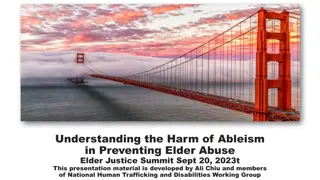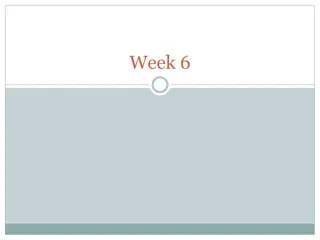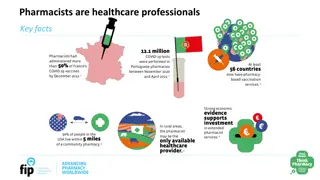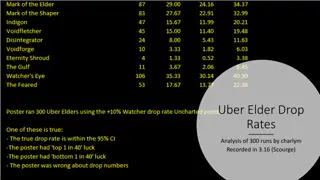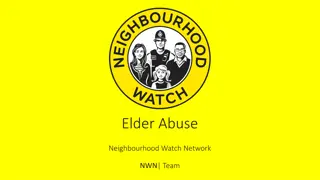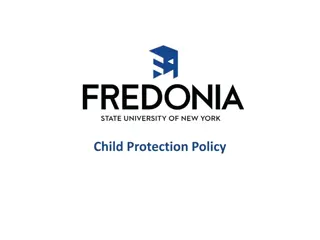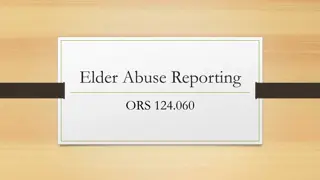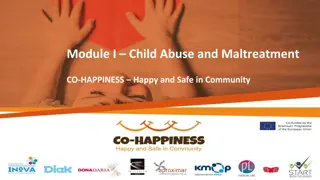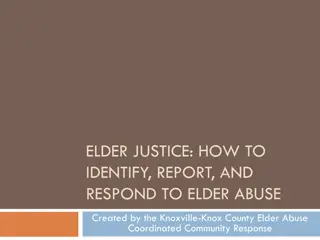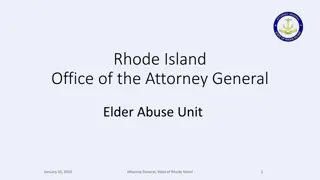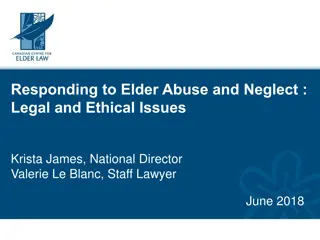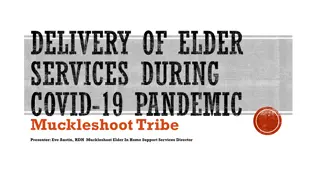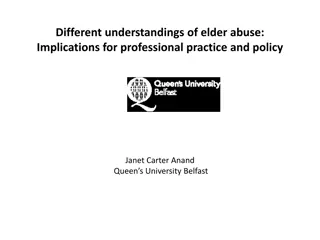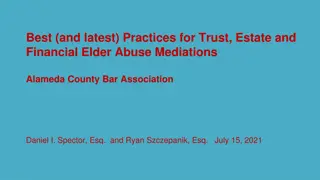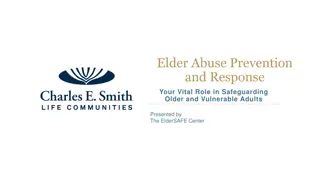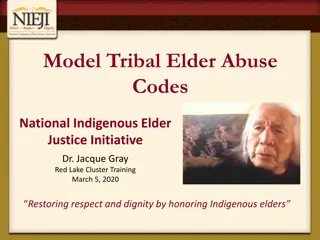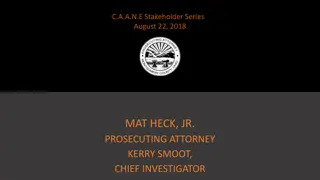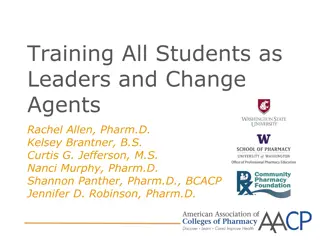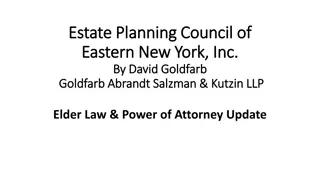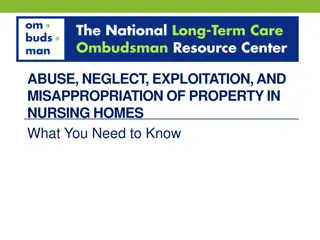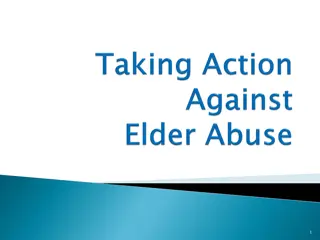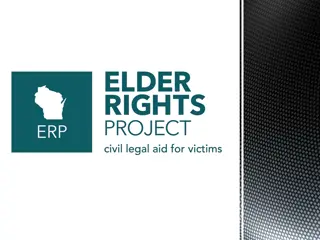Understanding Elder Abuse: A Guide for Pharmacists
This educational material created by the University of Southern California and the University of California, Irvine aims to train pharmacists on recognizing and reporting elder abuse. It covers important topics such as the types of elder abuse, pharmacists' role in detection, and legal considerations. The resource highlights the significance of pharmacists in safeguarding the well-being of older adults, given their frequent medication interactions with this vulnerable population.
Download Presentation

Please find below an Image/Link to download the presentation.
The content on the website is provided AS IS for your information and personal use only. It may not be sold, licensed, or shared on other websites without obtaining consent from the author. Download presentation by click this link. If you encounter any issues during the download, it is possible that the publisher has removed the file from their server.
E N D
Presentation Transcript
An Introduction to Elder Abuse for Pharmacists Created by: the University of Southern California, School of Pharmacy and the Center of Excellence on Elder Abuse and Neglect, University of California, Irvine Reaching Important Gatekeepers: Training Pharmacists about Elder Abuse
Questions 1. Which population group is the fastest growing in the U.S.? A. Children B. Teens C. Elders D. Women 2. Elder abuse most commonly occurs in nursing home and residential care facilities? True or False 3. Pharmacists do not need to report elder abuse unless they are sure that abuse has occurred. True or False 4. Suspected elder abuse in the community should be reported to ___________. 5. The three types of medication abuse are: ______________ ______________ and __________
Questions continued 6. Which of these is NOT an example of possible elder abuse? A. Although patient complains of pain, the caregiver rarely provides pain meds (prescribed PRN) to patient B. Family member responsible for providing care leaves bedbound person unattended all day C. Psychotropic drugs prescribed for Patient B are administered to Patient A to make her more agreeable D. Adult child refuses to have a baby in order to provide parents with the grandchild that they deserve
Why Talk about Pharmacists and Elder Abuse? Use of medication is the most common form of treatment in older people Medications are often potent substances, which may have low therapeutic to toxic dose ratio Seniors trust their pharmacists Pharmacists are in a position to see signs of elder abuse
Aging Demographics in U.S. Charts/graphs (global and US)
Elder Abuse is Any knowing, intentional, or negligent act by a caregiver or any other person that causes harm or a serious risk of harm to a vulnerable adult. National Center on Elder Abuse
Who is covered by elder abuse laws? In California, Those 65 years of age and older Those 18-64 years of age who have a disability Anyone who is a patient in a hospital Different states have different qualifying ages and other criteria. Learn your state s laws.
Types of Abuse Physical Abuse Financial Abuse Neglect Emotional Abuse Sexual Abuse Self-Neglect
Quick Quiz Question Which is the setting where elder abuse most commonly occurs? (a) Adult Day Care Center (b) Nursing Home (c) Home in the Community (d) Hospital
Elder Abuse Incidence FOR EVERY REPORT OF ABUSE . 5 GO UNREPORTED National Elder Abuse Incidence Study, 1998
Reports on the Rise In 2006 California APS agencies received over 104,000 reports of abuse and neglect, a 34 percent increase since 2000.
Medication Abuse Medication abuse occurs when medication is overused, underused or misused, resulting in harm to an older person The medication may or may not have been prescribed for the older person The abuse occurs within a relationship of implied trust
Overuse and Underuse Medication overuse occurs where medication is used for the correct indication but is given in higher doses than indicated Medication underuse occurs where medication is used for the correct indication but is given in lower doses than indicated, or is withheld
Medication Abuse Medication misuse occurs where: incorrect medication is given medication is given for the wrong reason or is used for a different purpose to its indication
FromRequest for Renewal of California Pharmacist License Under California law each person licensed by the Board of Pharmacy is a mandated reporter for both child and elder abuse or neglect purposes. What does this mean?
You must report elder abuse California Penal Code section 11166 and Welfare and Institutions Code section 15630 require that all mandated reporters make a report to an agency [generally law enforcement, state, and/or county adult protective services agencies, etc ] whenever the mandated reporter, in his or her professional capacity or within the scope of his or her employment, has knowledge of or observes a child, elder and/or dependent adult whom the mandated reporter knows or reasonably suspects has been the victim of child abuse or elder abuse or neglect.
How to Report Abuse In residential facilities: Long-term Care Ombudsman Social workers/volunteers Receive complaints from residents Advocate on behalf of residents Work with State Licensing to identify problems in facilities In the community: Adult Protective Services Social workers/nurses Receive reports of abuse from mandated reporters and others Work with elder/dependent adult to help them access resources in community to stay safe In many states: Cross report to police
Public Service Announcement Elder Abuse: The One Abuse Nobody Sees It s everyone s business!
Post-test questions 1. Which population group is the fastest growing in the U.S.? A. Children B. Teens C. Elders D. Women 2. Elder abuse most commonly occurs in nursing home and residential care facilities? True or False 3. Pharmacists do not need to report elder abuse unless they are sure that abuse has occurred. True or False 4. Suspected elder abuse in the community should be reported to ___________. 5. The three types of medication abuse are: ______________ ______________ and __________
Post-test questions continued 6. Which of these is NOT an example of possible elder abuse? A. Although patient complains of pain, the caregiver rarely provides pain meds (prescribed PRN) to patient B. Family member responsible for providing care leaves bedbound person unattended all day C. Psychotropic drugs prescribed for Patient B are administered to Patient A to make her more agreeable D. Adult child refuses to have a baby in order to provide parents with the grandchild that they deserve


